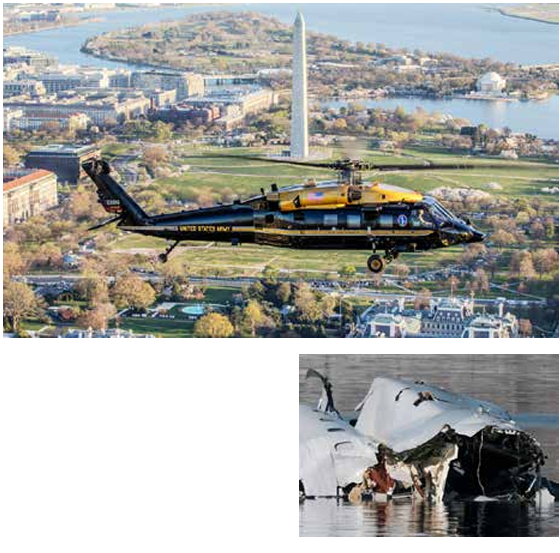
MID-AIR TRAGEDY OVER THE POTOMAC:
ANALYZING THE AMERICAN EAGLE AND BLACK HAWK COLLISION
On the evening of January 29, 2025, a devastating mid-air collision occurred over the Potomac River near Washington, D.C. This tragic event involved an American Eagle regional jet and a U.S. Army Sikorsky UH-60 Black Hawk helicopter, resulting in the deaths of all 67 individuals on board both aircraft. This incident marks one of the deadliest aviation disasters in recent U.S. history and has sparked urgent discussions about air traffic control management, military and civilian flight coordination, and regulatory oversight failures.
Details of the Incident
American Eagle Flight 5342, operated by PSA Airlines, was a Bombardier CRJ-701ER regional jet flying from Wichita Dwight D. Eisenhower National Airport to Ronald Reagan Washington National Airport (DCA). The flight carried 60 passengers and four crew members. Meanwhile, the Black Hawk helicopter was on a routine training mission involving airspace maneuver drills near restricted military airspace, carrying three military personnel. Preliminary investigations suggest that the collision occurred at approximately 8:47 p.m. EST, just as Flight 5342 was making its final approach to DCA. The Black Hawk, reportedly flying at an altitude of around 3,000 feet, entered the jet’s flight path, resulting in a catastrophic mid-air explosion. Witnesses described seeing a fireball over the river before both aircraft plunged into the icy waters.
Air Traffic Control and Communication Failures
One of the key elements under scrutiny is the role of air traffic control in managing conflicting flight paths. Initial findings indicate that there was only one controller on duty at the time of the crash—a situation that deviates from standard FAA protocols requiring at least two controllers for monitoring both military and civilian airspace. Moreover, reports suggest that the air traffic control supervisor had left their post early, leaving the tower understaffed during a critical period.
Additionally, questions are being raised about whether the helicopter crew had received timely clearance or whether they were operating in a known civilian corridor without proper coordination. The FAA is reviewing recordings of all communications between air traffic controllers and both aircraft to determine if miscommunications or delays played a role in the crash.
Investigating the Role of Surveillance and Avoidance Systems
Modern air traffic management relies on a combination of radar surveillance, Automatic Dependent Surveillance–Broadcast (ADS-B) systems, and Traffic Collision Avoidance Systems (TCAS). Commercial aircraft like the Bombardier CRJ-700 are equipped with TCAS, which automatically alerts pilots to potential conflicts. However, military helicopters, particularly those on training missions, may not always be required to have active transponders enabled, reducing their visibility to civilian aircraft.
Investigators are examining whether the Black Hawk had its transponder activated and if the American Eagle crew received any TCAS alerts prior to impact. If the helicopter’s transponder was off or malfunctioning, this could have significantly reduced the regional jet’s ability to detect and react in time.
Potential Contributing Factors
1. Airspace Management Issues
The Potomac River region is known for its complex airspace, which includes restricted military zones, high-density commercial flight corridors, and helicopter operations for law enforcement and government agencies. While military aircraft are allowed to conduct training exercises near civilian airspace, strict coordination is required to prevent conflicts.
2. Weather Conditions
Meteorological data at the time of the crash indicated clear skies but freezing temperatures, which may have contributed to challenges in emergency response and recovery efforts. However, weather conditions do not appear to have played a direct role in the collision itself.
3. Human Factors
The possibility of human error on multiple levels—from air traffic control staffing issues to pilot situational awareness—is a major avenue of investigation. Fatigue among controllers, potential misinterpretations of instructions, and pilot reactions under time-sensitive conditions are all being evaluated.
4. Regulatory Oversight and Military Protocols
The National Transportation Safety Board (NTSB) and the FAA are reviewing whether there were lapses in regulatory compliance, including whether military training protocols were adhered to in terms of flight planning and coordination with civilian air traffic controllers.
Community Impact and Mourning
The tragedy has deeply affected numerous communities. Among the victims were members of the figure skating world, including former champions and young aspiring athletes. The Skating Club of Boston and other organizations have held vigils in memory of those lost.
Nationally, the incident has reignited concerns over aviation safety and airspace management near densely populated urban centers. Families of the victims have begun demanding answers from the authorities, with some advocating for stronger oversight of military-civilian air traffic coordination.
Moving Forward: Safety Recommendations
As investigations progress, several safety recommendations are expected to emerge:
Mandatory transponder activation for all military aircraft operating near civilian corridors.
Enhanced air traffic staffing requirements to ensure proper monitoring of high-traffic airspace.
Improved real-time coordination protocols between the FAA and military operations.
Regular joint training sessions for civilian and military pilots to improve situational awareness.
The collision between American Eagle Flight 5342 and the Black Hawk helicopter serves as a sobering reminder of the complexities and risks inherent in modern airspace management. While mechanical failures have not been indicated as primary causes, systemic issues—ranging from air traffic control oversight to procedural failures—are at the heart of the ongoing investigation.The final NTSB report, expected within a year, will provide definitive conclusions, but immediate policy changes and safety enhancements may be required long before then to prevent a similar tragedy from occurring in the future.